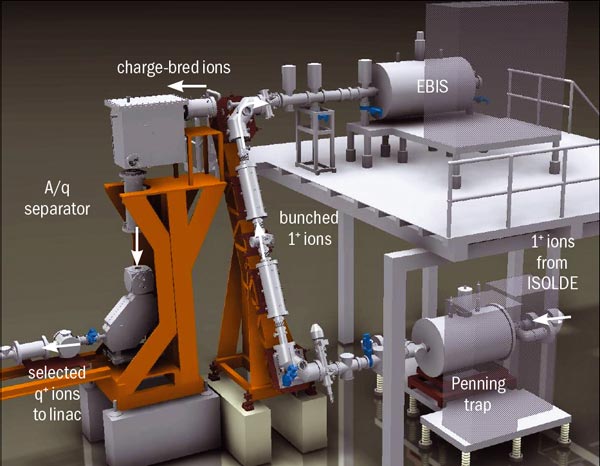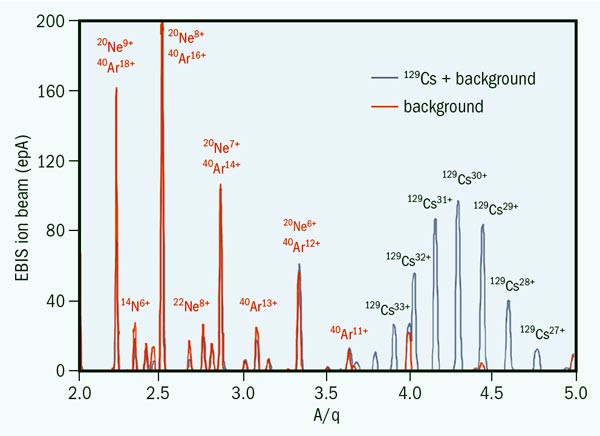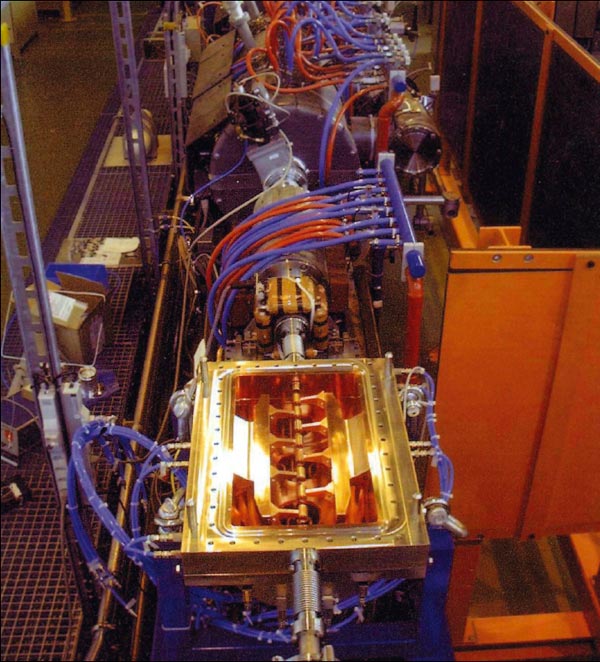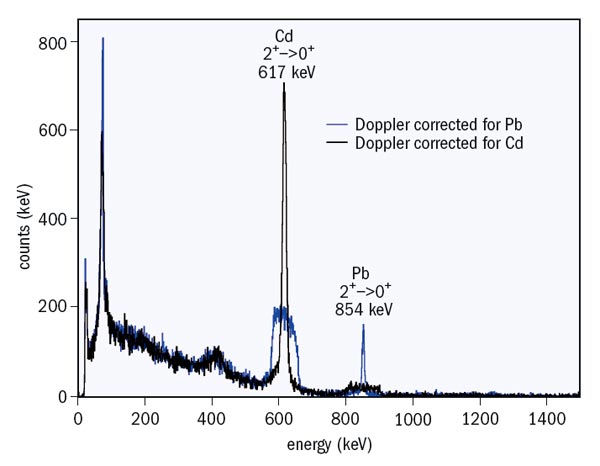REX-ISOLDE provides a range of radioactive ion beams.

Image credit: V Barozier.
The evolution of nuclear structure through the list of stable nuclear isotopes was well established by the late 1960s. During the following decades, however, the discovery of more and more short-lived nuclei expanded the nuclear chart – revealing several surprises. For example, the nuclear shells, which give the classical “magic numbers” along the line of stability, have been seen to change position and sometimes even to dissolve in highly unstable (exotic) nuclei. Only now is the field approaching a fundamental understanding of how nuclear shells evolve. To follow these changes in nuclear structure, nuclei must be probed in many complementary ways. Therefore the leading nuclear-physics facilities not only give access to many different isotopes but also allow a variety of experiments to be performed.
The introduction of REX-ISOLDE at CERN’s ISOLDE facility a decade ago (Kester et al. 2000) allowed a major step forward, as ions produced in the Isotope On-Line (ISOL) facility could be accelerated to a completely new energy region. Before the introduction of REX-ISOLDE, the experiments at ISOLDE took place at low energy (up to 60 keV) via decay studies, ion-beam measurements or manipulation. The natural extension of these techniques was to include reaction studies such as Coulomb excitation, capture reactions and transfer reactions. The challenge was to devise a universal, fast, efficient and cost-effective acceleration scheme that would take full advantage of the large range of isotopes available at ISOLDE.
The idea for the REX-ISOLDE “post-accelerating” scheme emerged in 1994, the acronym coming from “Radioactive beam EXperiments at ISOLDE”. The added accelerator had to increase the beam energy to a few million electron-volts per atomic mass unit (MeV/u). Its key ingredient is an innovative scheme for preparing ions that combines a Penning trap with an electron-beam ion source (EBIS) – REXTRAP and REXEBIS, as illustrated in figure 1. The semi-continuously released radioactive 1+ ions from the ISOLDE target, produced by the impact of 1.4 GeV protons from the Proton Synchrotron Booster, are accumulated and phase-space cooled in the buffer-gas-filled Penning trap, before being sent in a bunch to REXEBIS. So called “charge breeding” takes place inside the EBIS, i.e. the conversion of the ions from 1+ to q+ by bombardment with a dense, energetic electron beam. The highly charged ions, now with a reduced mass-to-charge ratio (A/q <4.5), are extracted and separated before being post-accelerated in a room-temperature linear accelerator (linac). The high charge state allows for efficient acceleration in the compact linac. REX-
ISOLDE pioneered this charge-breeding scheme for radioactive ions and now several facilities around the world are replicating the concept (Wenander 2010).
Versatile acceleration
Although REX-ISOLDE has a modest final beam energy compared with other CERN accelerators, it compensates by being agile and flexible. It was initially designed to perform post-acceleration of neutron-rich Na and K isotopes, all with masses below A = 50. Since then the mass range has been extended and radioactive elements from light 8Li to heavy 224Ra have been accelerated for experiments. To accelerate the heavier elements, high charge states – for example, above 50+ for Ra – have to be achieved to fulfil the A/q requirement of the linac. Neither stripping foils nor gas-jet stripping can be used to obtain such charge states at low energies, so the challenging task falls entirely on the charge breeder. By increasing the breeding time, sometimes up to 300 ms, REXEBIS can nevertheless efficiently convert the ions to the required high charge states.

Because REX-ISOLDE also has the ability to cover the high mass-range for ions it is possible to make full use of ISOLDE’s capability to produce heavy radioactive elements by spallation processes in targets of uranium carbide. This is a unique feature that so far no other radioactive ion-beam facility can challenge. The combination of a Penning trap and EBIS has also proved capable of accepting almost all chemical elements produced by ISOLDE because the ions are kept within the traps without any surface contact.
The duration of the cooling and the charge breeding is of secondary importance for radioactive elements with long half-lives. On the other hand, some radioactive isotopes of interest have short half-lives, potentially leading to decay losses of the rare ions. By optimizing the cooling and the breeding, even elements such as 11Li (t1/2 = 8.5 ms) and 12Be (t1/2 = 23.6 ms) have been post-accelerated successfully. To reduce the decay losses further, continuous injection from the ISOLDE target-ion source into REXEBIS – without prior bunching and cooling in REXTRAP – can be performed at the expense of a slightly lower transmission efficiency.
The purity of the radioactive ion beams is an important factor. Because there are often only a few thousand ions per second, corresponding to subfemtoampere beams, there is a real interest in suppressing as much contaminating beam components as possible. The excellent vacuum of REXEBIS is one of the requirements for good beam purity. Still, even with a vacuum of better than 10–11 mbar, the residual gas ions – such as C, N, O, Ar and Ne (the latter being the buffer gas in the Penning trap) – usually dominate the beam extracted from the EBIS. In the A/q spectrum shown in figure 2, the residual gas ions appear in discrete peaks, while the background between the peaks is very clean. Thus, by correctly choosing the A/q value of the radioactive beam – in this case abundantly injected 129Cs – the contaminating beam components can be avoided. By adjusting the time the radioactive ions are trapped within the EBIS, and therefore the time ions are exposed to the electron-impact ionization process, the charge state and hence the A/q of the extracted ions is changed.
The low-energy side of REX is a toolbox full of means for beam-manipulation exercises. One of the latest tools to be added is the “in-trap decay” method, used for producing elements that are not readily available from ISOLDE for chemical reasons, such as Fe. A short-lived isotope of abundantly produced Mn is taken from ISOLDE, injected into the EBIS and kept there for a few hundred milliseconds until the major fraction has decayed to Fe, before being accelerated to the experiment. This method can be used to access isotopes of several elements new to ISOLDE, such as B, Si, Ti and Zr.
Another tool, aimed at improving the beam purity and suppressing isobaric contaminants from ISOLDE, for instance Rb superimposed on Sr, is the molecular sideband method. Instead of extracting the ions of interest as atomic 1+ ions from ISOLDE, a carrier gas – in this case CF4 – is introduced and the ions are extracted as SrF+. Because of the electron configuration, the Rb contaminant does not form an RbF+ molecule and can therefore be suppressed in the ISOLDE separator. Inside the EBIS, the SrF+ is broken up and the Sr charge bred in the normal way before being accelerated to the experiment.
Yet another method of beam purification is to make use of the inherent mass-selectivity of the Penning trap. The injected ion cloud from ISOLDE, containing both the ion of interest and the isobaric contamination, is excited to a large radius inside the 3 T magnetic field of REXTRAP. Thereafter, a mass-selective cooling mechanism is applied, re-centring only the ions of interest, while the contamination is lost on extraction. A mass resolution in the order of 30,000 – a factor six times higher than with the High-Resolution Separator at ISOLDE – has been demonstrated for ions with mass number A in the range of 30 to 40.
Selected results
At the start, REX-ISOLDE made use of five room-temperature accelerating cavities to reach a maximum energy of 2.2 MeV/u. In 2004, a 9-gap interdigital H-type cavity was added to the linac, which boosted the final energy to approximately 2.9 MeV/u. Through stepped activation of the six accelerating cavities, the energy of the ion beam can be varied from 300 keV/u (the energy of the RF quadrupole cavity) up to the maximum energy.

The demand for beam time by the experiments is high, and many different beams – up to 10 elements and 20 isotopes plus several stable calibration beams – have to be delivered every year. This has to be done efficiently, in terms of both set-up time and beam transmission, because the exotic ions are difficult to produce. Until now, REX-ISOLDE has accelerated close to 100 isotopes of 30 different elements (P Van Duppen and K Riisager 2011).
A major theme in the experiments performed so far has been the tracking of the evolution of nuclear shells. The first hints for the breaking of the classical magic numbers came from experiments at CERN on neutron-rich nuclei with about 20 neutrons, in what is now called the “island of inversion”. Several REX experiments have contributed to clarifying the structure in this region. One of the latest combined a radioactive 30Mg beam with a radioactive tritium target to do two-neutron transfer to two 0+ states in 32Mg, the data being consistent with the closed-shell configuration in the excited state rather than the ground state.
In the region of the classical neutron magic number 50, a campaign of experiments has probed how shells evolve towards 78Ni, presumably still a double magic nucleus. Both transfer- and Coulomb-excitation experiments have been performed, the latter including one that made use of another speciality of ISOLDE: isomeric beams. ISOLDE’s laser ion source can in certain cases – such as the heavy Cu isotopes – produce beams of an isotope that is mainly in either its ground state or in a long-lived (isomeric) state. This extra selectivity helps greatly in interpreting complex spectra that result when these beams react.
In the light mass region REX experiments are also testing the extent of shell-breaking in the nucleus 12Be (neutron number 8), but the physics implications are broader because the accelerated isotope in this case, 11Be, is a halo nucleus with an unusually large spatial extent. The halo structure implies that continuum degrees of freedom play an important role. An extreme example of this is the neighbouring halo nucleus 11Li that is bound although its subsystem 10Li is particle unbound. The structure of 10Li has also been studied in transfer experiments at REX.

Image credit: J Pakarinen.
As a final example, at the other end of the nuclear chart several experiments are tracking the sizeable changes in shape that are known to take place systematically among light isotopes of elements around Pb. Coulomb excitation favours transitions among collective states and has allowed the identification of different shapes in nuclei from 182Hg to 204Rn.
Apart from these nuclear physics examples, the REX-ISOLDE accelerator has also been used for physics-application studies. These include the calibration of plastic foils of polyethylene terephthalate (PET), for use as solid-state nuclear track detectors, and for development work on diamond detectors.
REX-ISOLDE is a machine undergoing constant development to fulfil the changing requests of the experiments. Currently, the possibility of producing polarized nuclear beams with the tilted foil method is being investigated. The beam energy will also be increased in a few years’ time – first to 5 MeV/u and ultimately to 10 MeV/u – within the framework of the High Intensity and Energy ISOLDE project, HIE-ISOLDE. This will be achieved by adding superconducting cavities to the accelerating linac (Pasini et al. 2008). The increased energy range will open up a wide field of reaction studies and keep REX-ISOLDE fully booked for at least another decade.







